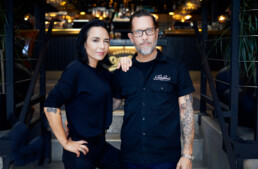Jean-Pierre Peugeot and Jean-Frédéric Peugeot established their eponymous French company in 1810. By 1842, they produced coffee, pepper, and salt grinders. The company’s entry into the vehicle market was via crinoline dresses (a stiffened or structured petticoat designed to hold out a woman’s skirt, popular at various times since the mid-19th century), which used steel rods, leading to umbrella frames, saw blades, chisels, wire wheels, and bicycles. Armand Peugeot introduced his “Le Grand Bi” penny-farthing in 1882; seven years later he built his first automobile.


With a primary focus on city use, the vehicle’s small footprint (nearly eight foot long by a little more than two-and-a-half feet wide) and rotating doors free up road space and make for quick and easy parallel parking. [Groupe PSA]
With all this momentum, Peugeot has invested its resources into future mobility solutions, based on a plug-in hybrid electric vehicle (PHEV) with tilting wheels and a tandem passenger design; let’s call it the e-Tilt. Based on architecture similar to a tricycle, Peugeot’s electrified light vehicle is adapted for urban and short trips with a zero-emission mode for city driving.
Funded with 6.7 million euros from the European Commission under the “Horizon 2020 GV5” Research and Innovation program, the e-Tilt is part of the “Efficient Urban LIght Vehicle” (EU-LIVE) European consortium, bringing together 12 partners from six countries, with Groupe PSA the only carmaker. One of the EU-LIVE consortium’s main objectives is to develop common powertrains that can be used for a variety of L-category vehicles to achieve economies of scale.
The e-Tilt runs in zero-emission mode at speeds up to 44 mph using two rear electric in-wheel motors, developed by Elaphe and Brembo.The 48-volt electric battery—designed by Samsung SDI—can be recharged using regenerative braking technology. When driving between 44 and 80 mph, the e-Tilt’s 31-KW single-cylinder gas engine takes over. The light vehicle has a total range of 186 miles and a top speed of 80 mph.

“Groupe PSA has committed to protecting individual freedom of movement,” Peugeot’s Senior VP of Research and Advanced Engineering Carla Gohin said. “EU-LIVE is an illustrative example of it. This new electrified light vehicle allows an individual safe and sustainable mobility thanks to its zero-emission mode. We are proud to take part in this European project with all our partners.”




Are tiling vehicles of any kind … ICE or EV the future ? Well they certainly are a good idea as proven by the most sophisticated of all tilters … the Mercedes Benz ‘ Carver ‘ . Problem is many have tried yet all have failed to capture the publics imagination and wallet with both three wheels and four .
So though I’m a fan … I’ll say an unequivocal … no … unfortunately .
No, it´s not the Microliner. And it´s not the Twizy. Or the electric Smart. None of the existing small, urban, electric vehicles could entice me off my 600cc, gas guzzling CCM motorbike. I can weave in and out of traffic and through tailbacks. I´m nearly always able to be at the front at traffic lights, and then accelerate out of harm´s way, faster than a Ferrari. I can park anywhere, free of charge. I can do most repairs on my own. But I know that, at my age (83) I´ll have to look around for a (non-existing) alternative quite soon. Experience and logic point in the direction of a narrow (max. 80cm width), leaning, four wheeled, fully enclosed single or two-seater. The technology is proven. Leaning, three wheeled scooters are nothing new, and several prototypes are usually on show at the major international events: the Yamaha MWC-4, the Israeli City Transformer, the Swiss Tremola, the Polish Triggo and the Spanish Torrot Velocipedo all tick most of my boxes. Phillip James (http://tiltingvehicles.blogspot.com/2010/07/tva-phillip-james.html) has done the theoretical groundwork. But NONE of the major car or motorbike manufacturers have been willing to invest in a solution to urban traffic congestion. They just can´t move on from making immense SUVs and are unable to see that they´re shoveling their own graves.
The problem is simply due to very few engineers understanding tilting vehicle dynamics but that does not stop them getting grants of 6.7 million euros from the European Commission under the “Horizon 2020 GV5” Research and Innovation programme Has the Peugeot tilter ever actually moved under its own power?… where is the ” demonstration” of what all of the money actually produced and by ” produced” I don’t mean ” prototypes that have never been driven”. Its a never ending story of stripping money from the European Commission and ” publishing papers” and not learning anything .